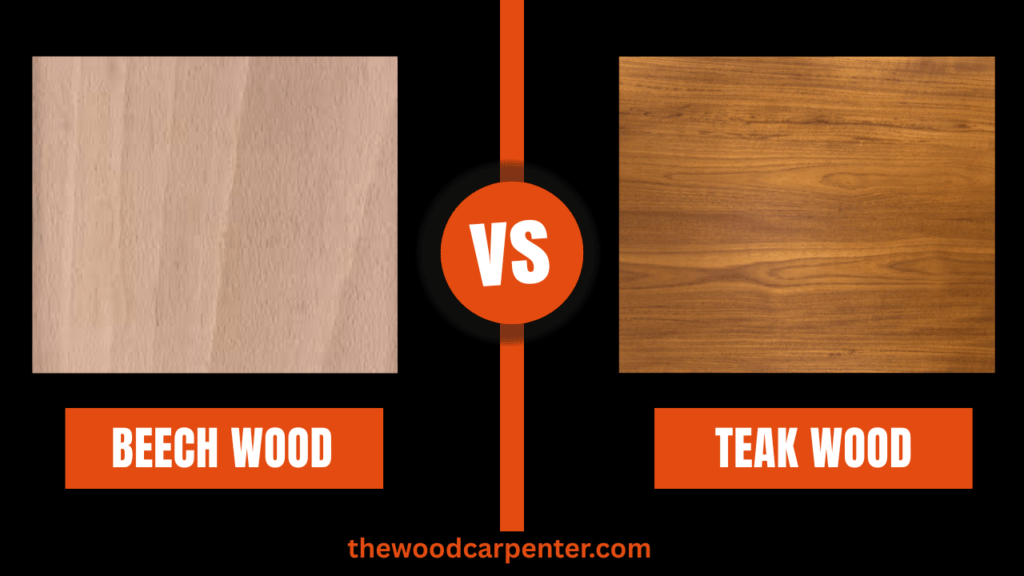
When picking the right wood for furniture or building projects, beech wood and teak wood are both considered high-quality choices, but they are very different in their properties, uses, and costs. Both woods have been important in making quality furniture, flooring, and decorative items worldwide.
This article will explain beech and teak wood in detail, covering where they come from, their features, types, advantages and disadvantages, best uses, and answers to common questions.
Understanding Beech Wood
Where Does Beech Wood Come From?
Beech wood comes from trees in the Fagus family, which grow in temperate areas of the Northern Hemisphere. The two main types of beech wood are European Beech (Fagus sylvatica) and American Beech (Fagus grandifolia). These trees grow slowly and steadily, producing strong and reliable wood.
What Does Beech Wood Look Like?
- Color: Beech wood is pale cream when freshly cut, sometimes with a pink or brownish tint. Over time, it darkens to a reddish-brown color.
- Grain & Texture: The grain is fine, straight, and tight, and the surface feels smooth. It sometimes has attractive flecks created by the medullary rays.
- Hardness: Beech wood is moderately hard, with a rating of about 1,300 lbf on the Janka scale (used to measure wood hardness).
- Density: It is heavy and dense, which gives it good shock resistance.
- Smell: Beech wood has a mild, non-lingering smell.
How Durable is Beech Wood?
- Water & Pest Resistance: Beech wood is not very durable outdoors, as it can rot if exposed to damp conditions for long periods. However, it holds up well to regular wear indoors.
- Elasticity: Beech has good flexibility and shock resistance, making it ideal for curved furniture and designs that need bending.
- Workability: It is easy to cut, shape, glue, and finish, and it takes stains well.
What is Beech Wood Used For?
- Furniture: Beech wood is often used to make chairs, tables, cabinets, and bentwood furniture.
- Flooring: It is popular for flooring because of its smooth texture and even color.
- Musical Instruments: Beech is used in making drum shells, piano pinblocks, and other parts that need to produce good sound.
- Other Uses: Beech wood is also used for tool handles, toys, kitchen items, veneers, and firewood.
Types of Beech Wood
Beech wood comes in several varieties, each with its own unique appearance and uses:
European Beech (Fagus sylvatica): This variety is commonly used in furniture. It has a pale, creamy color, which may have a slight pink or reddish tint. European beech is highly valued for its strength and is often used in high-end joinery and veneers.
American Beech (Fagus grandifolia): Found in North America, this beech is a bit darker and coarser than European beech but is similarly valued for its strength and workability. It’s also used in furniture making and woodworking.
Japanese Beech (Fagus crenata) & Chinese Beech (Fagus engleriana): These types are popular in Asian woodworking. They are appreciated for their consistent texture and moderate hardness, making them suitable for a variety of furniture and craft applications.
Copper Beech (Fagus sylvatica purpurea): Known for its beautiful purple leaves, copper beech is more commonly used for decorative and specialty woodwork rather than for structural uses.
Weeping Beech (Fagus sylvatica Pendula): This variety is notable for its drooping branches and is often used for ornamental purposes. It is less common but can be found in unique furniture designs and as an ornamental tree.
Other Varieties: There are ornamental beech varieties like Dawyck beech, Fern-leaf beech, and Mexican beech, known for their unique foliage. While these trees are often appreciated for their appearance, their wood is also durable and used in various applications.
Also read:
Maple or Cherry Wood? The Best Pick Revealed !
Best Wood Types for Furniture: Revealed !
Understanding Teak Wood
Where Teak Comes From
Teak (Tectona grandis) originally grows in the tropical forests of Southeast Asia. Today, it’s also grown on plantations in Asia, Africa, and South America. Teak is known for being extremely strong and long-lasting. It’s often called the best wood for outdoor furniture, boats, and high-end flooring.
How Teak Looks and Feels
- Color: When freshly cut, teak is golden to medium brown. It becomes darker with time.
- Grain and Texture: Usually straight grain, sometimes a bit wavy. The texture is rough but feels oily or waxy because of its natural oils.
- Hardness: Rated around 1,070 on the Janka scale, meaning it’s harder than most common woods.
- Density: It’s a heavy wood that stays strong and doesn’t shrink much.
- Special Feature: Teak has a light scent, similar to leather, because of the natural oils in the wood.
Strength and Protection
- Water and Pest Resistance: Teak naturally resists water, bugs, and rot better than most other woods. That’s why it’s used for boat decks and outdoor furniture.
- Aging: If left outside without polish or oiling, teak turns a beautiful silver-gray color—this is a sign of real teak.
Common Uses for Teak
- Furniture: High-end outdoor chairs, tables, benches, and indoor furniture too.
- Boats: Used for decks, rails, and trim because of its resistance to water.
- Floors and Stairs: Great for homes in humid or tropical areas.
- Decorative Woodwork: Perfect for doors, windows, and even wood art.
Types of Teak Wood
Teak varies by region and age; these categories help define its quality and best uses:
| Type | Source / Description | Typical Usecases |
| Burmese Teak | Old-growth Myanmar forests. The highest oil content and tightest grain. | Marine use, luxury outdoor and indoor furniture. |
| Thai Teak | Native to Thailand; light color, affordable, durable. | Indoor and garden furniture. |
| Indian Teak | Grown in India; affordable, less durable than Burmese teak. | Interior furniture, carvings. |
| Indonesian Teak | Plantation-grown, high consistency, sustainable. | Flooring, furniture, veneers. |
| African (“Iroko”) | Technically not true teak, but similar strength and resistance. | Decking, furniture where affordability is key. |
| Heartwood Teak | Inner core of older trees, rich oil, best durability. | Marine, premium furniture. |
| Sapwood Teak | Outer wood, lighter color, less oil, less durable. | Lower-grade applications. |
| Old-Growth vs Plantation Teak | Old-growth (80–100+ years) is denser and more durable; plantation (20–40 years) is sustainable but less dense. | High-end vs. utility/eco-friendly options. |
Detailed Comparison Table: Beech Wood vs Teak Wood
| Feature | Beech Wood | Teak Wood |
| Origin | Temperate regions (Europe, US, Asia) | Tropical Asia, Africa, South America |
| Color | Pale cream to reddish-brown (darkens with age) | Golden brown to deep brown; develops silver-gray patina |
| Grain & Texture | Straight, fine grain; smooth, tight; medullary flecks | Straight to wavy, coarse, oily surface |
| Hardness (Janka) | ~1,300 lbf (European beech) | ~1,070 lbf |
| Durability | Good indoors; susceptible to rot/pests outdoors unless treated | Exceptionally durable against rot, insects, and moisture |
| Water Resistance | Poor (not for outdoors unless treated) | Excellent |
| Workability | Easy to machine, bend, and finish | Dense, requires sharp tools; gluing can be tricky |
| Cost/Availability | Affordable, widely available | Expensive, limited (especially high-grade Burmese) |
| Uses | Furniture, flooring, utensils, musical instruments | Outdoor & indoor premium furniture, marine, flooring |
| Sustainability | Generally sustainable | Must check for certification; plantation teak is eco-friendly |
Pros and Cons of beech and teak wood
Beech Wood: Pros & Cons
✔ Pros:
- Has an even color and grain—perfect for modern or classic furniture.
- Affordable and easy to find.
- Bends well when steamed—great for curved designs.
- Takes stain and polish nicely.
- Strong against impact—ideal for furniture that gets used a lot.
✘ Cons:
- Not resistant to water or pests (not good for outdoor use unless treated).
- Heavier than many other hardwoods.
- Can shrink or warp in humid places.
- Not as tough as teak in wet or outdoor conditions.
Teak Wood: Pros & Cons
✔ Pros:
- Extremely strong and long-lasting.
- Naturally resists rot, bugs, and moisture.
- Stays strong outdoors for decades with little care.
- Beautiful grain and rich color—turns silver-grey over time if left untreated.
- High resale value and a luxury look.
✘ Cons:
- Much more expensive than other woods.
- Harder to find and may raise environmental concerns.
- Very heavy and can be harder to cut or shape.
- Natural oils make it tricky to glue or finish.
When Should You Choose Beech or Teak?
Go with Beech Wood if:
- You’re on a budget and need good-looking wood for indoor use.
- You want curved furniture or bentwood projects.
- Your project won’t be exposed to moisture.
Choose Teak Wood if:
- You need strong, low-maintenance wood for outdoor or wet areas (like bathrooms or boats).
- You’re making high-end furniture that should last many years.
- You want luxury and a natural, beautiful finish.
Frequently Asked Questions (FAQs)
Q1: Is beech wood as strong as teak?
No. Beech is strong, but teak is much more durable—especially in wet or humid places.
Q2: Can I use beech wood outdoors?
Only if it’s properly treated. Even then, it won’t last as long as teak.
Q3: Why is teak so expensive?
Teak grows slowly, is in high demand, and is carefully regulated. This makes it more valuable, especially Burmese teak.
Q4: What are the main types of beech wood?
- European Beech
- American Beech
- Japanese Beech
- Others include copper beech, weeping beech, and fern-leaf beech—each with its own look and best uses.
Q5: Are there environmental concerns with teak?
Yes. Wild teak is often overharvested. Choose FSC-certified or plantation-grown teak to protect forests.
Q6: How do I care for teak furniture?
Just clean it regularly. You can oil it to keep its golden color, or leave it alone to turn silver-gray naturally.
Q7: Is beech wood safe for kitchen use?
Yes! Beech is food-safe and commonly used for cutting boards, spoons, and kitchen tools.
Q8: Which is better for beginners—beech or teak?
Beech is easier to work with. It bends well, finishes nicely, and is beginner-friendly.
Final Thoughts
Beech Wood is great for:
- Indoor furniture
- Curved or bent designs
- Budget-friendly projects
- Kitchen tools
Teak Wood is ideal for:
- Outdoor and marine use
- Long-term durability
- High-end and luxury projects
- Low-maintenance furniture
When choosing between beech and teak, think about:
- How much you want to spend
- If the wood will be indoors or outdoors
- The look and finish you want
- How much maintenance you’re okay with
- Sustainability and eco-friendliness
Making the right choice will help your project last longer, look better, and be more enjoyable to build!

